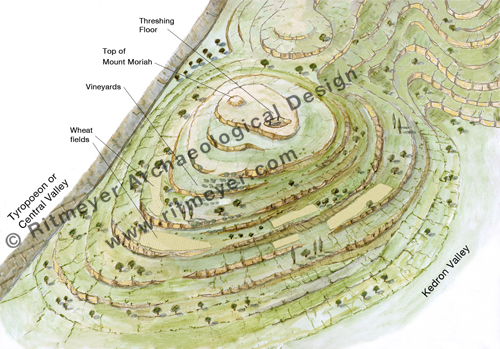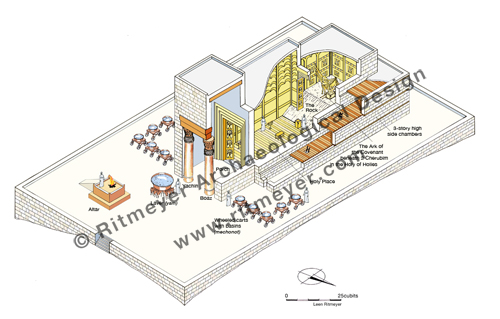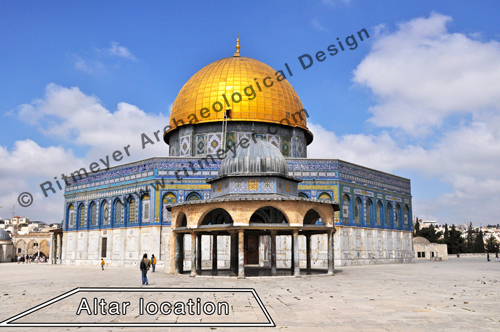The next drawing of Mount Moriah that was prepared for our new Temple Mount Guide Book (and now available in our Image Library) shows what the mount would have looked like in the Jebusite period. Araunah the Jebusite was the last pre-Israelite ruler of Jerusalem, or Jebus, as it was then called. At the end of the second millennium BC, the mountain was used for growing wheat and barley, as attested to by the reference to the threshing floor of Araunah in 1 Chronicles 21.15. After God had brought a plague on Israel, the angel of the Lord, who was about to destroy Jerusalem, told King David to build an altar on the threshing floor.

But where exactly was that threshing floor? Was it on the very top of Mount Moriah, i.e. on the Rock (Sakhra) now located inside the Dome of the Rock, or elsewhere? Many people believe the altar built by Abraham to sacrifice his son Isaac was situated on top of the Rock and that later the Temple altars were built there.
We have shown, however, that the Rock was the Foundation Stone for the Holy of Holies of Solomon’s Temple and all subsequent Temples and not the location of the altar.

We are told that the angel in 1 Chron. 21.16 was standing on higher ground, between heaven and earth as it were. That place was most likely the peak of Mount Moriah and the subsequent sanctity of the Rock is therefore derived from the presence of the angel.
The threshing floor must have been on lower ground to the east, to exploit the prevailing westerly winds to separate the chaff from the grain. Threshing floors are never located on the very top of mountains, as the strong westerly wind would blow away both chaff and grain, but always on lower ground, usually on the eastern side.
Jewish tradition maintains that David’s altar was built (c. 980 BC) on the same place that Abraham had erected his altar in preparation for the sacrifice of Isaac, before God intervened. Based on the relationship between Herod’s Temple and the Rock inside the Dome of the Rock, the altar would have been located just east of the Dome of the Chain, as depicted in this photograph:

The first drawing of Mount Moriah appeared here.
The next drawing in this series is the Temple Mount during the time of Solomon.

How fascinating to re-read this. I am so thankful that we got to see Jerusalem with you… I will never forget my husband’s reaction when he heard that yes, we had been booked on the tour of 2000!!! He had a smile on his face for weeks!!! From here, the blessings will go out to all the world – and how the world needs a wise ruling hand!
Beulah,
That was a wonderful trip and we were so glad that you and Don were with us. We all miss him very much.
b”h
Shalom Leen,
I appreciate your work. I wonder if you know of any online material that examines the claims of Robert Cornuke who recently wrote a book, _Temple_, which locates Solomon’s Temple in the City of David, an idea which is based on the theory of Ernst Martin. I live in Jerusalem and believe the temple mount is the actual location, but a comprehensive examination and refutation would be helpful if you have one, or know of one.
Best wishes.
Hanoch
Shalom Hanoch,
Cornuke’s ideas are indeed an identical copy of Martin’s ideas. I once wrote a rebuttal which has been published again recently, see:
https://prophecywatchers.com/response-dr-ernest-l-martin/
b”h
Thank you so much Leen. I greatly appreciate it.
Best wishes.
Professor Ritmeyer, I was wondering if Araunah and the Jebusite king at the time of David’s overtaking Jerusalem are one and the same person?
I have a second question, that is concerning Melchizedek and one of his successors Adonizedek. Is Melchizedek an ancestor to Adonizedek?
Edward,
Yes, I believe that the Jebusite king at the time of David was Araunah. We don’t know if Melchizedek had a successor or not. The names Melchizedek and Adonizedek are titles (King of Righteousness and Lord of Righteousness respectively), rather than names.
This is how Bob Cornuke shows 2 Chronicles 3:1 in his book: Then Solomon began to build the house of the LORD at Jerusalem…in the place that David had prepared in the threshingfloor of Ornan the Jebusite.
So what is the missing words in this verse and why did he leave them out?
Then Solomon began to build the house of the LORD at Jerusalem in mount Moriah, where the LORD appeared unto David his father, in the place that David had prepared in the threshingfloor of Ornan the Jebusite.
This verse says the Temple was built on mount Moriah which is where the Temple mount is and not the Gihon springs.
Paul Myers Brantford Ontario
Paul,
Well spotted!
Hello,
I am very interested in your book Carta and the publishing there of. Do you have an email list that I can get on? My name is Ben Kelly and my email address is benjamin.kelly566@ Gmail.com.
Thank you.
Hi Ben, all our books are available on Amazon: https://www.amazon.com/s/ref=nb_sb_noss_2?url=search-alias%3Daps&field-keywords=Ritmeyer
Hope you can find the book you are interested in.
How come Bishop Ushers time line does not agree with the Septuagint LXX or the Dead Sea scrolls. Check out Luke, his time line is different and not based on the corrupted massorite text.